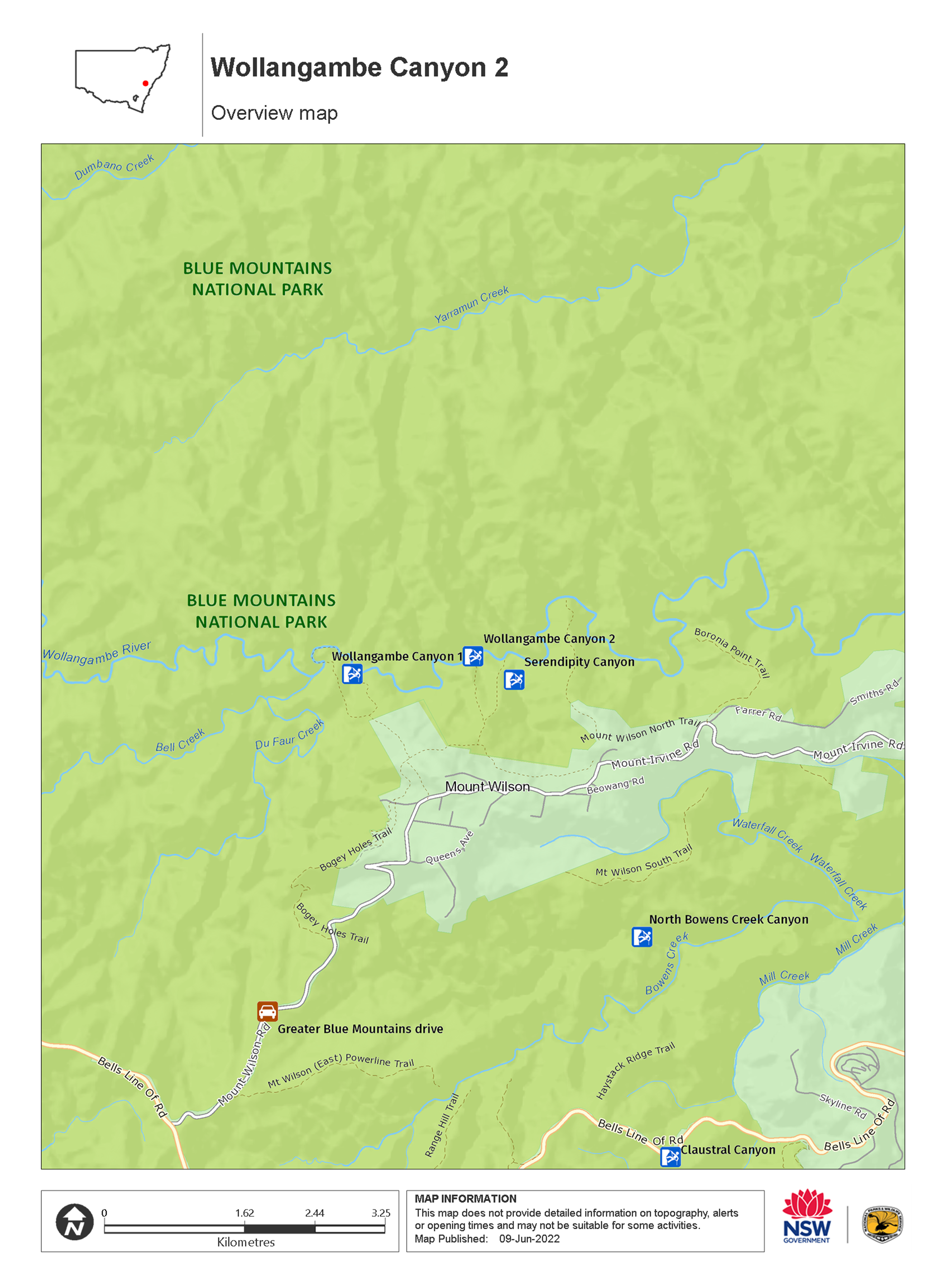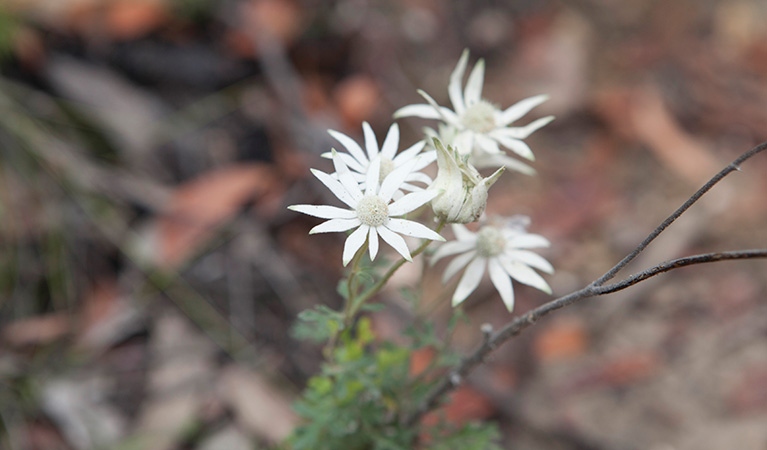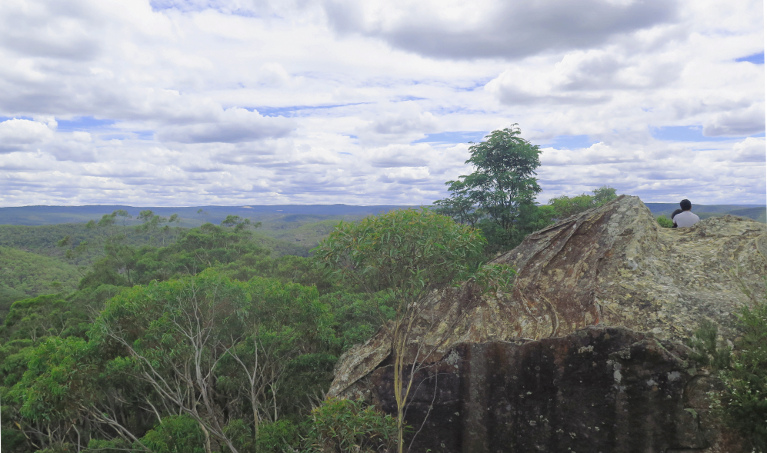Wollangambe Canyon 2
Mount Wilson area in Blue Mountains National Park
Overview
For fit canyoners and strong swimmers only, Wollangambe Canyon 2 is a long canyon route near Mount Wilson. Good navigational skills are a must to make the 9km walk in and out.
- Accessibility
- No wheelchair access
- Time suggested
- 10hrs
- Grade
- Hard. You must be a strong swimmer with a high level of fitness. It’s challenging to navigate to and from this canyon. Good navigational skills are essential.
- Trip Intention Form
-
It's a good idea to let someone know where you're going. Fill in a trip intention form to send important details about your trip to your emergency contact.
- Personal Locator Beacon
-
If you're planning to loan a Personal Locator Beacon (PLB) from one of these locations, wait and fill out your trip intention form in person.
- What to
bring - Drinking water, inflatable float, helmet, wetsuit, first aid kit, mobile phone, dry bag, personal locator beacon, sturdy shoes, suitable clothing, topographic map, snacks, compass
- Please note
- Don’t visit the canyon just before, during or after heavy rainfall or storms. Check park alerts before you go.
- You may encounter commercial tour groups.
- Planning a guided tour? Choose a Park Eco Pass operator. Only Parks Eco Pass holders are permitted to operate tours in Blue Mountains National Park.
Also known as the Wollangambe Canyon Lower Tourist Section, this 2.4km canyon is non-technical but still poses many challenges. Taking up to 10hrs to complete, it includes exposed climbs, jumps, difficult scrambles, long swims and a trek of 9km to walk in and out.
Long, warm summer days are the best time to do Wollangambe Canyon 2, to avoid getting too cold in the chilly river waters. Don't forget your wetsuit and be sure to bring a lilo, pack raft of other type of inflatable float.
Starting from Cathedral Reserve, walk west along Northern Fire Trail for 1.2km then veer right at the fork, heading downhill. After reaching the top of a long hill where you'll see a warning sign, turn right and head north another 1.5 km to the river.
To reach the river, there's an exposed 300m down-climb using tree roots. Soon after entering the canyon you'll arrive at a difficult jump or 2m down-scramble. This canyon also features many more scrambles over massive boulders, lots of long swims, and a steep climb out.
Map

Map legend

Local alerts
For the latest updates on fires, closures and other alerts in this area, see https://www.nationalparks.nsw.gov.au/things-to-do/adventure-sports-experiences/wollangambe-canyon-2/local-alerts
General enquiries
- National Parks Contact Centre
- 7am to 7pm daily
- 1300 072 757 (13000 PARKS) for the cost of a local call within Australia excluding mobiles
- parks.info@environment.nsw.gov.au
Park info
- in the Mount Wilson area of Blue Mountains National Park in the Sydney and surrounds region
Mount Wilson area is always open but some locations may close at times due to poor weather or fire danger.
Visitor info
All the practical information you need to know about Wollangambe Canyon 2.
Maps and downloads
Learn more
Wollangambe Canyon 2 is in Mount Wilson area. Here are just some of the reasons why this park is special:
A haven for plants and animals

As you’d expect of an area named after famous botanist Sir Joseph Banks, Mount Banks has rich plant and animal life. Around 1,000 types of flowering plants call the park’s diverse environments home, including the NSW floral emblem—the waratah. Watch the vegetation change from open woodland to low-growing heath and bare rock as you walk to Mount Banks summit. At the summit, fertile basalt soil allows tall trees like monkey gums to grow. The trees were named by early European explorers who mistook the resident gliders for monkeys. On ridge tops you may see hanging swamps or the rare Blue Mountains cliff mallee tree, found only in the upper mountains on exposed cliff edges.
- Mount Banks Summit walk For some of the best scenic views in the Greater Blue Mountains Area World Heritage Property, try the steep Mount Banks Summit walk from the picnic area, near Mount Wilson.
Ancient landscapes

The distinctive double hump of Mount Banks was formed by lava 12 to17 million years ago, during volcanic eruptions. While softer sandstone eroded over years to carve out the Grose Valley and rocky escarpments, thick basalt layers atop Mount Banks, Mount Tomah and Mount Wilson protected the sandstone underneath. The sheer Banks Wall, an exposed cliff face 510m high, provides a window into the geology of this area. It’s best viewed from Perrys Lookdown in the Blackheath area of the park.
- Blue Mountains wilderness navigation training This exciting guided weekend in Blue Mountains National Park with MountainSphere Adventures and Education challenges you to boost your ability to navigate with a map and compass.
- Mount Banks Road cycle route With scenic wilderness views, wildflowers and birdwatching, Mount Banks Road is a great mountain bike ride and walking track, near Mount Tomah, in Blue Mountains National Park.
- Mount Banks Summit walk For some of the best scenic views in the Greater Blue Mountains Area World Heritage Property, try the steep Mount Banks Summit walk from the picnic area, near Mount Wilson.
- Wollangambe Canyon 1 You need to be fit and a strong swimmer to do Wollangambe Canyon 1, a long canyon near Mount Wilson. Navigational skills are also important for this route.
- Wollangambe Canyon 2 For fit canyoners and strong swimmers only, Wollangambe Canyon 2 is a long canyon route near Mount Wilson. Good navigational skills are a must to make the 9km walk in and out.
World-class wilderness

The Grose Wilderness is the only declared wilderness area in Blue Mountains National Park. The walks and cycle route at Mount Banks are some of the easiest ways to explore this protected area. At the heart of the Grose Wilderness is the magnificent Blue Gum Forest. This closed forest of tall blue gum trees is one of the most secluded areas in the Blue Mountains. It also played an important role in the beginnings of the park and conservation movement in NSW. In 1932, the forest was saved from the axe when a group of bushwalkers pooled their money to buy out the lease. Almost 100 years later, intrepid hikers can hike into this natural wonder via Pierces Pass, off Bells Line of Road. Near Mount Wilson, Du Faurs Rocks lookout offers views north into the Wollangambe and Wollemi wilderness areas.
- Blue Mountains wilderness navigation training This exciting guided weekend in Blue Mountains National Park with MountainSphere Adventures and Education challenges you to boost your ability to navigate with a map and compass.
- Mount Banks Road cycle route With scenic wilderness views, wildflowers and birdwatching, Mount Banks Road is a great mountain bike ride and walking track, near Mount Tomah, in Blue Mountains National Park.
Greater Blue Mountains Area World Heritage Property

Blue Mountains National Park is 1 of 8 national parks and reserves that make up the Greater Blue Mountains Area World Heritage Property. In 2000, UNESCO recognised the area's outstanding geology, biodiversity, and Aboriginal significance. The area lies within the Country of the Darug, Gundungurra, Wiradjuri, Darkinjung, Wanaruah and Dharawal People. With 1 million hectares of rugged plateaux, sheer cliffs, deep gorges, it protects unique ecosystems teeming with rare plants and animals. Over 95 species of eucalypt trees have evolved here over millions of years, making it the most diverse eucalypt forest in the world. Greater Blue Mountains driving route is a great way to see this ancient wilderness right on Sydney doorstep.
- Wollangambe Canyon 1 You need to be fit and a strong swimmer to do Wollangambe Canyon 1, a long canyon near Mount Wilson. Navigational skills are also important for this route.
- Wollangambe Canyon 2 For fit canyoners and strong swimmers only, Wollangambe Canyon 2 is a long canyon route near Mount Wilson. Good navigational skills are a must to make the 9km walk in and out.
Plants and animals protected in this park
Animals
-

Sugar glider (Petaurus breviceps)
The sugar glider is a tree-dwelling Australian native marsupial, found in tall eucalypt forests and woodlands along eastern NSW. The nocturnal sugar glider feeds on insects and birds, and satisfies its sweet tooth with nectar and pollens.
-

Bare-nosed wombat (Vombatus ursinus)
A large, squat marsupial, the Australian bare-nosed wombat is a burrowing mammal found in coastal forests and mountain ranges across NSW and Victoria. The only other remaining species of wombat in NSW, the endangered southern hairy-nosed wombat, was considered extinct until relatively recently.
-

Yellow-tailed black cockatoo (Calyptorhynchus funereus)
The yellow-tailed black cockatoo is one of the largest species of parrot. With dusty-black plumage, they have a yellow tail and cheek patch. They’re easily spotted while bird watching, as they feed on seeds in native forests and pine plantations.
-

Superb fairy wren (Malurus cyaneus)
The striking blue and black plumage of the adult male superb fairy wren makes for colourful bird watching across south-eastern Australia. The sociable superb fairy wrens, or blue wrens, are Australian birds living in groups consisting of a dominant male, mouse-brown female ‘jenny wrens’ and several tawny-brown juveniles.
-

Superb lyrebird (Menura novaehollandiae)
With a complex mimicking call and an elaborate courtship dance to match, the superb lyrebird is one of the most spectacular Australian animals. A bird watching must-see, the superb lyrebird can be found in rainforests and wet woodlands across eastern NSW and Victoria.
-

Swamp wallaby (Wallabia bicolor)
The swamp wallaby, also known as the black wallaby or black pademelon, lives in the dense understorey of rainforests, woodlands and dry sclerophyll forest along eastern Australia. This unique Australian macropod has a dark black-grey coat with a distinctive light-coloured cheek stripe.
-

Wedge-tailed eagle (Aquila audax)
With a wingspan of up to 2.5m, the wedge-tailed eagle is Australia’s largest bird of prey. These Australian animals are found in woodlands across NSW, and have the ability to soar to heights of over 2km. If you’re bird watching, look out for the distinctive diamond-shaped tail of the eagle.
-

Eastern bentwing-bat (Miniopterus schreibersii oceanensis)
Eastern bentwing-bats congregate in caves across the east and north-west coasts of Australia, in colonies of up to 150,000. These small Australian animals weigh around 13-17g and can reach speeds of up to 50km per hour. Eastern bentwing-bats use both sight and echolocation to catch small insects mid-air.
Plants
-

Blueberry ash (Elaeocarpus reticulatus)
The blueberry ash is a rainforest shrub which produces blue olive-shaped berries and spectacular bell-shaped flowers, which often appear on the plant together. It is a tall slender shrub or small tree found in rainforest, tall eucalypt forest and coastal bushland in eastern NSW, south-east Queensland and Victoria.
-

Flannel flower (Actinotus helianthi)
The delicate flannel flower is so named because of the soft woolly feel of the plant. Growing in the NSW south coast region, extending to Narrabri in the Central West and up to south-east Queensland, its white or pink flowers bloom all year long, with an extra burst of colour in the spring.
-

Grass tree (Xanthorrea spp.)
An iconic part of the Australian landscape, the grass tree is widespread across eastern NSW. These Australian native plants have a thick fire-blackened trunk and long spiked leaves. They are found in heath and open forests across eastern NSW. The grass tree grows 1-5m in height and produces striking white-flowered spikes which grow up to 1m long.
-

Waratah (Telopea speciosissima)
The beautiful waratah is not only the NSW floral emblem, it's also one of the best-known Australian native plants. This iconic Australian bush flower can be found on sandstone ridges around Sydney, in nearby mountain ranges and on the NSW South Coast. The waratah has a vibrant crimson flowerhead, measuring up to 15cm across, and blossoms in spring.
-

Old man banksia (Banksia serrata)
Hardy Australian native plants, old man banksias can be found along the coast, and in the dry sclerophyll forests and sandstone mountain ranges of NSW. With roughened bark and gnarled limbs, they produce a distinctive cylindrical yellow-green banksia flower which blossoms from summer to early autumn.
-

Smooth-barked apple (Angophora costata)
Smooth-barked apple gums, also known as Sydney red gum or rusty gum trees, are Australian native plants found along the NSW coast, and in the Sydney basin and parts of Queensland. Growing to heights of 15-30m, the russet-coloured angophoras shed their bark in spring to reveal spectacular new salmon-coloured bark.

